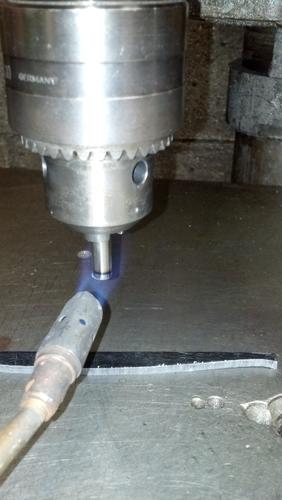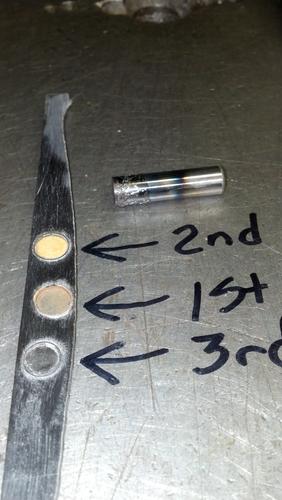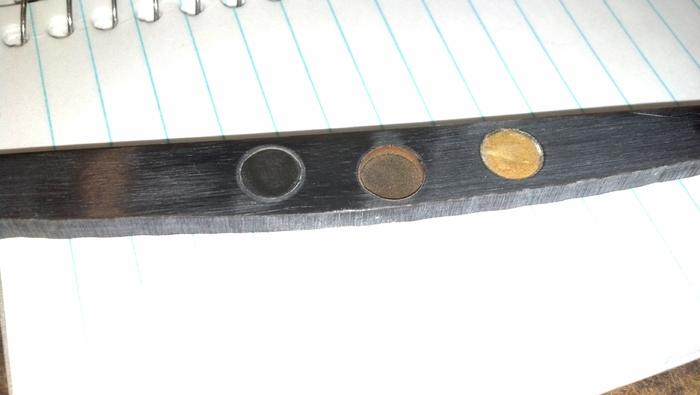Results 11 to 20 of 27
Thread: Pressed Horn
-
01-18-2014, 02:25 PM #11

hidrogen peroxide is not flammable as far as I know, but it does supports burning, it definitely can cause skin "burns" when concentrated.. I guess you could use it for bleaching also?
@geezer: H2O2 is oxidizer, this is sth you might need at the end...
first you must reduce the the -S-S- bonds resulting in -SH HS- ... in this state a remodelling the form would have to take place and than at the end removing the reducing agent, maybe oxidizing as well (where peroxide can come into place) but take care that the oxidation won't damage the horn .. I think the best thing would be to ask an older hairdresser how they did it..
reducers that we use (in the lab) are eg B-mercaptoethanol, dithiotreithol, but these are extremely strong, toxic, cancerogenic (fumes also) and would not be a good choice,.. not to mention that the smell like ****** ..
when you do this stuff definitely take care of the fumes, take care of skin and eyes protection also, you are doing with high temps, pressure, aggressive chemicals (i guess) and high pressure (to some extent)!!
-
01-18-2014, 03:47 PM #12

Thanks guys! I did not intend to go further with the Peroxide experiments. Rocket science I do not need. I prefer to get to heaven the slow way!You have supplied a good answer to others who may consider the idea!
Respectfully
~RichardBe yourself; everyone else is already taken.
- Oscar Wilde
-
01-18-2014, 04:10 PM #13

I really don't think you need to worry about oxidizers. Horn is a thermoplastic, so you can just heat it until it becomes pliable, then work, then cool, and the working will be set. I don't think hair is strictly thermoplastic on its own, hence the need to engineer a different way to permanently curl it (as you said generally with new disulphide bond linkages after hair proteins are moved to a different conformation).
-
01-18-2014, 06:36 PM #14

I also am not sure about the composition, presence and frequence of disulphide bonds. Since they are evolutionary speaking originating from hair i think they should have pretty similar composition.
Oxidizers: what you need is REDUCENT, not oxidizer. The oxidizer might be used at the end to stabilize the form. Also oxidizers might hydrolize the ceratin etc, so I would defenetely apply them with caution.
-
01-18-2014, 10:27 PM #15

When I read your previous post, I was thinking about just the same chemicals. I work with dithiothreitol a lot currently and I'm relieved it doesn't smell as bad as beta-mercaptoethanol. I once carefully smelled a 1000x dilution of the latter and nearly choked.
As for the horn, I just ordered an untreated horn without doing the research first, which is my regular way of doing things. Can I make scales from it without pressing or treating it?I want a lather whip
-
01-18-2014, 10:33 PM #16Historically Inquisitive



- Join Date
- Aug 2011
- Location
- Upstate New York
- Posts
- 5,782
- Blog Entries
- 1
Thanked: 4249
Absolutely! This thread discussion is more towards pressing horn design into scales.
-
The Following User Says Thank You to Martin103 For This Useful Post:
Tarkus (01-27-2014)
-
01-18-2014, 10:38 PM #17

Thanks, that's good news! I bought a 50 cm streaked and pretty straight cow horn for €20, which should arrive on Tuesday. If I can make a couple of scales out of that and a brush or two without the need of any more tools/equipment than I currently have, I'm going to call that money well spent.
Meanwhile, I'll be reading up on horn. If you have links to good info, I'm all ears I want a lather whip
I want a lather whip
-
01-26-2014, 08:36 PM #18

The next step, here, obviously, is making a metal mold that'll fit into a righteous vise that in turn will fit into a nicely heat-controlled oven.
Things I wonder about:
- Does the mold need to be gradually tightened?
- What sort of releasing agents would be good? Old school was tallow, but I wonder about things like modern non-stick cooking juice.
- I had always assumed simple iron molds, but there are a lot of other materials that might be up to the job and easier to work with.
- Am I going to be evicted because of the smell?
-Zak Jarvis. Writer. Artist. Bon vivant.
-
01-26-2014, 08:40 PM #19

I would think you could preheat the platens and your horn, then just tighten outside of the oven.
1. No clue. But I would think a one-time tightening would work.
2. You should still be able to get tallow if you look around.
3. Just have to look into the mold-horn wetting properties so you don't glue the horn to the mold. But other materials should work as well, as long as the thermal properties of steel molds aren't overly specific to the process.
4. Yes
-
01-27-2014, 12:54 PM #20Senior Member



- Join Date
- Dec 2011
- Location
- I'm Gonna Spend Another Fall In Philadelphia
- Posts
- 2,010
Thanked: 498
This has been a great thread thanks Geezer.
It has sparked an experiment with me to see what the definition you would get in horn if you heat a punch and under pressure (drill press) hot stamp horn. I have a friends Plumacher razor that needs rescale it has a wonderful inlay badge (Blue Wonder) on the front scale. I would love to dig out the badge from the old scale and being a Tool & Die maker form grind in a piece of steel the outside shape of the badge heat up the stamp and hot stamp the shape of badge into the horn. So all I would have to do is glue the badge into the stamped cavity.
This morning I did a test with a dowel pin with a flattened end a torch and my drill press. I was astonished to see the definition and the depth you could get doing this.
I did three hits from the same heating with no down stops. The first pull was the hottest and did the most depth. as the pin cooled the depths became shallower.
The depths are as follows
First hit .053" deep
Second hit .016" deep
Third hit .004" deep
I was stunned to see the definition it gave, the corners are nice and sharp.



After this successful test, I think I will try to do this hot stamp inlay badge process.
Thanks for the ideas guys.
Darl (Tarkus)Last edited by Tarkus; 01-27-2014 at 01:00 PM.


 45Likes
45Likes LinkBack URL
LinkBack URL About LinkBacks
About LinkBacks






 Reply With Quote
Reply With Quote

